Arm Announces Neoverse N1 & E1 Platforms & CPUs: Enabling A Huge Jump In Infrastructure Performance
by Andrei Frumusanu on February 20, 2019 9:00 AM ESTFirst N1 Silicon: Enabling the Ecosystem with SDPs
A little known fact about Arm is that the company designs its own silicon test platform – actually deploying them on development board to enable validation and software development on hardware that Arm and developers have full control of. The latest generation was the Juno platform, which in its first revision started off with a Cortex A57 and served as the fundamental silicon testbed for ARMv8 software.
Ever since Arm started the programme in 2014, Arm has shipped over 1400 boards both internally and to its partners. The amount of chips we’re talking about here sounds paltry, however we have to keep in mind we’re talking about very limited shuttle runs on MPW (multi-project wafers) where Arm shares wafer space with numerous other companies.
For today’s announcement, Arm had the pleasure to reveal that it received back the first working Neoverse N1 silicon back in December – with the chips meant to be integrated into the new Neoverse System Development Platform (SDP).
The N1 SDP represents major step for Arm as it not only is the first silicon to come back with the N1 CPU, but also is Arm’s first own 7nm silicon. The platform represents a major proof of concept of the IP, as well as interoperability with third-party IP, employing a lot of the peripheral IP such as PCIe and DDR PHY supplied by Cadence.
The actual hardware is a limited implementation of an N1 SoC – we find a 4-core N1 CPU with 1MB L2 configuration in the form of 2xMP2 connected to a CMN-600 with an 8MB SLC setup.
The board includes a CCIX compatible PCIe 4.0 x16 slot which serves the crucial role of enabling development and demonstrating cache-coherent integration with CCIX hardware such as Xilinx’s FPGA.
The N1 SoC actually doesn’t contain dedicated I/O IP, rather Arm implements all connectivity via a dedicated FPGA which serves as the I/O hub, supporting various connectivity options such as Ethernet, USB, SATA and so on.
Naturally the big selling point of the SDP is its completely open-source firmware stack from not only the OS drivers, but more importantly the SCP and MCP firmware.
An important new feature that is first employed by the new N1 CPU is the introduction of statistical profiling extensions (SPE). The new extension enables the first ever self-hosted profiling capability in an Arm CPU – meaning we don’t require a separate CPU or system having to read out microarchitectural counters. Instead the new SPE can be configured to directly write this information into memory. The tool is extremely useful for tracing code and analysing core behaviour, identifying possible performance issues and further squeezing out the maximum performance out of a platform, something Arm is taking very seriously if it wants to succeed and gain adoption in HPC.
Finally, the N1 SDP will be available later this quarter – although don’t expect the board to be easily attainable for the average user.


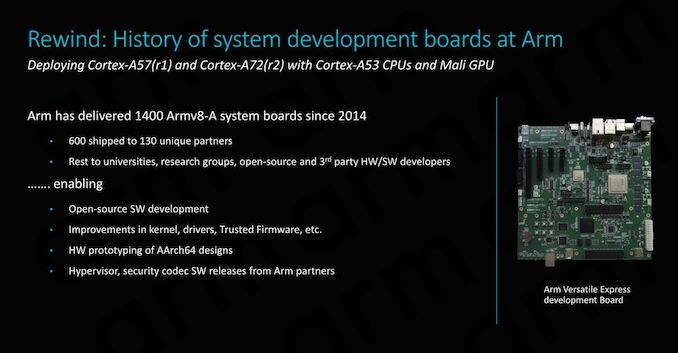
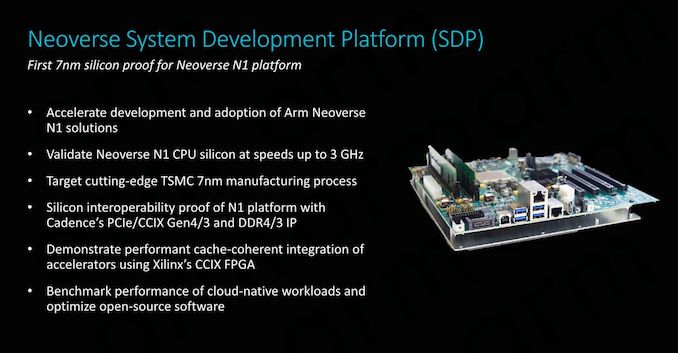
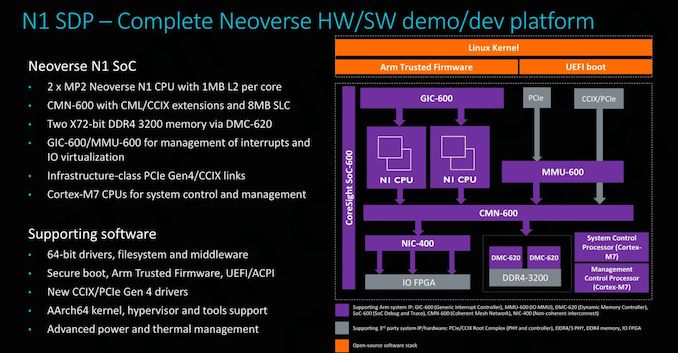
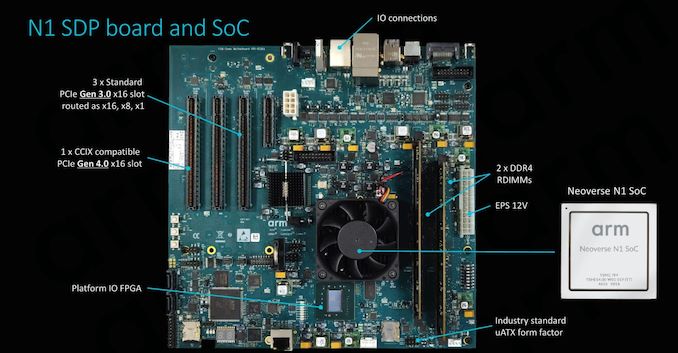

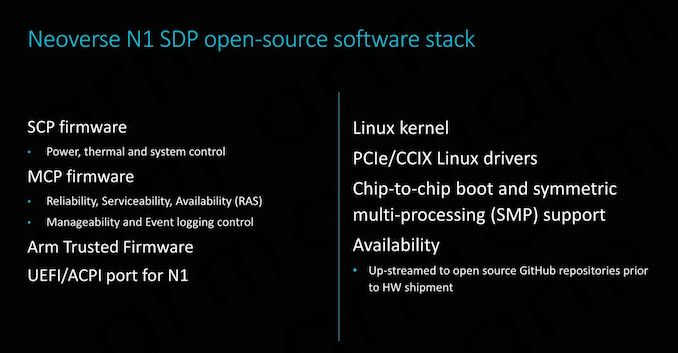

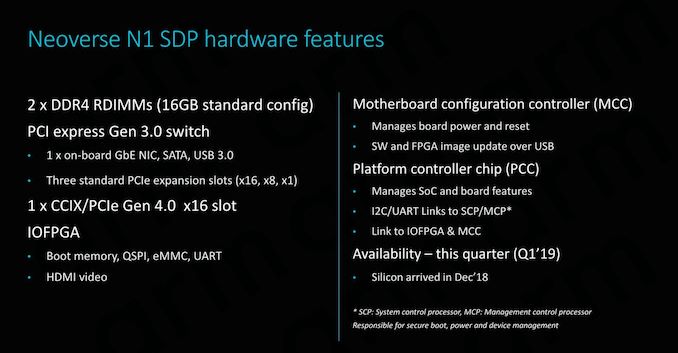








101 Comments
View All Comments
platinumjsi - Thursday, February 21, 2019 - link
Wouldnt mind seeing an Anadtech article detailing the differences between X86 and Arm and explaining the benefits and downsides of each architecture.Looking at this if ARM can do 64 cores for 105w I have to wonder why it takes AMD 250w on the same process?
Intel / AMD should be seriously worried about this.
Could we see ARM-based Laptops / Desktops? Wouldnt be any good for gaming as I cant see devs recompiling there back cataloge for ARM but for Office use these seem ideal.
SarahKerrigan - Thursday, February 21, 2019 - link
ARM laptops already exist, running Windows. Look at the Asus NovaGo or the Lenovo Yoga C630.edzieba - Thursday, February 21, 2019 - link
ARM still has to overcome the same issue that killed off every other HPC architecture (barring POWER just about hanging in there): not being x86 ( http://3s81si1s5ygj3mzby34dq6qf-wpengine.netdna-ss... ).Antony Newman - Thursday, February 21, 2019 - link
Perhaps this will all change when Apple move over to an ARM ISA? Apple would have to offer a system that is at least as capable as x86 with a significantly lower lower TCO. I think the limitation up until know was the wimpiness of the ARM offerings; the offerings were cheap but not performant.javadesigner - Friday, February 22, 2019 - link
What does the "A" in ARM stand for ? I always thought it was Apple. Does Apple make any licensing money when Samsung makes an (A)pple(R)(M) chip ?TobiWahn_Kenobi - Saturday, February 23, 2019 - link
Acorn RISC MachinesTobiWahn_Kenobi - Saturday, February 23, 2019 - link
Nowadays Advances RISC Machines.darkich - Sunday, February 24, 2019 - link
.. Isn't this basically (as expected) an expansion of the Cortex A76 architecture?techbug - Sunday, June 9, 2019 - link
intel w-3175x's rate score doesn't look right. Its single-thread score is 48.18 and 56T is 729.82. So each thread only contributes only 729.82/56=13.03, which seems to be too low.obi210 - Sunday, February 2, 2020 - link
A Neoverse E1 derivative, without SMT, could be the next gen Arm little core. Such a core with Armv9 support could provide near A73 performance. In-order A53 derivatives should not be carried over to next gen.